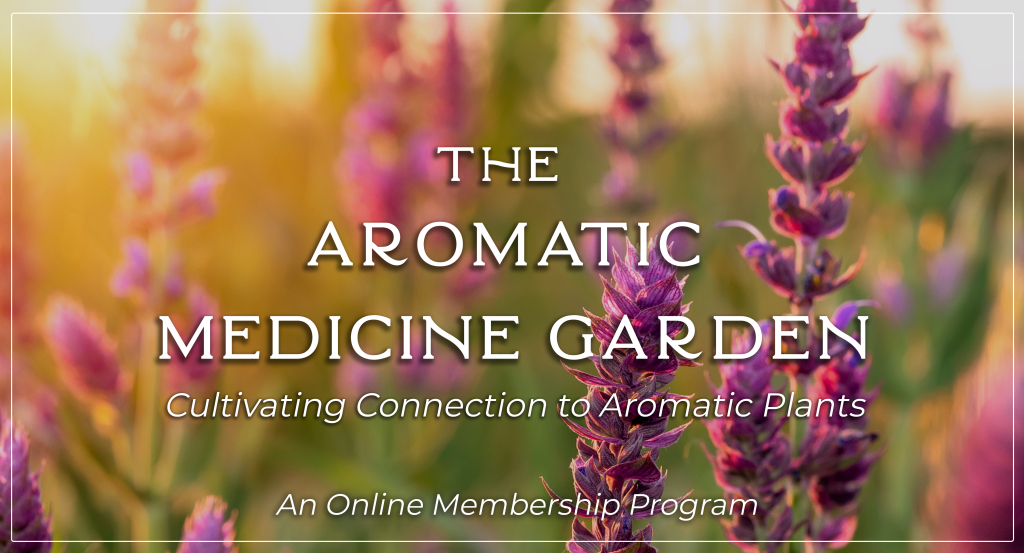
Some might say that the words sustainable and essential oil can never be in the same sentence. Essential oils have dynamic health benefits, however, they’re also resource-intensive products. Hundreds to thousands of pounds of fresh plant material are required to make only 1 gallon of essential oil [1].
Unfortunately, the rise in popularity of aromatherapy and essential oil use has also caused detrimental damage to wild plant populations and the environment. A majority of the plant products on the market in Europe and the U.S. are derived from wild plants. There are between 50,000-80,000 flowering plant species worldwide used for medicinal purposes and about 15,000 of them are threatened with extinction from over-harvesting and habitat destruction [2]. Commodification comes at a cost – the current loss of plant species is between 100-1000 times higher than the projected natural extinction rate [3].
Aromatic plants and herbal medicine offer us rich diversity and a wide range of health benefits. So can we have our plant-based cake and eat it too? In the bigger picture, it’s imperative that we find a healthy balance between conserving endangered plants and plant-based material production. In addition, it's important as individuals to consider learning about our own local wild plants, or even growing our own.
Let’s explore the sustainability story of Spikenard, the conservation efforts around this powerful plant, and how to learn from this case-study to help preserve other endangered aromatic plants.
The Benefits of Spikenard
Indian Spikenard, also known as Jatamansi, is the root of the perennial plant Nardostachys jatamansi. It grows at high-altitudes throughout the Himalayas on cliffs and mountain tops of Bhutan, China, India, Myanmar and Nepal. Spikenard is not as well-known as Sandalwood or Frankincense (which are also endangered, by the way), but it has an ancient history of use in aromatic medicine, incense and perfumery.
Spikenard holds much spiritual significance throughout various biblical and other esoteric belief systems. It was used in the form of anointing oil by Mary of Bethany, to anoint the feet and head of Jesus in the Biblical story. It was also one of the ingredients in the famous Ketoret incense, burned in the Temple of Solomon.
Spikenard is closely related to Indian Valerian (Valeriana wallichii) and they share similar health benefits; both are calming to the nervous system, however, Spikenard has a more energizing and uplifting effect on the mind, while Valerian can be more sedating [4]. Spikenard has been traditionally and historically used to help relieve stress, trauma, depression, and other psychological struggles. The essential oil is believed to have anticancer, antimalarial, and pain relieving effects [4].

Spikenard’s Sustainability Issues
Spikenard is one of Nepal’s most commercially valuable plants and consequently heavily exploited species. Today, between 100-500 tons of roots are harvested from high altitude Himalayan regions and at least 15,000 people across the region depend on that harvest for 25% of their annual income [6].
The rising popularity of natural healing products and herbs across the Western world is exciting, however, the increased interest has caused higher demand for wild plants, which are limited resources. One of the main aspects of this complex issue is that wild-growing plants are more at risk than cultivated ones. One solution has been to start cultivating some of these endangered wild plants; however, not all wild plants can be successfully grown on farms or plantations. Spikenard falls into this category [5].
Spikenard populations have dwindled due to high demand, exploitation, deforestation, forest fires, and excessive animal grazing [7]. In 1997, Spikenard was listed as endangered by the Convention on International Trade in Endangered Species. This resulted in an immediate ban on all trade of Spikenard without proper permits. However, 8 years later, Spikenard moved into the “critically endangered” category by the International Union for Conservation of Nature [5].
Despite it’s at-risk status and strict regulations, it continues to be illegally over-harvested, traded, and smuggled, due to increasing demand and reliance on the income it provides [4]. Due to poor infrastructure, extreme poverty, and lack of work options in these regions, the major occupation opportunities of the people there are farming livestock and wild-harvesting. The reality of the situation is that many people, with good reason, are willing to risk breaking the “rules” at the expense of the environment when their livelihoods depend on it.
Bouncing Back
In 2018, conservation groups stepped in to help native locals in the Himalayas learn how to sustainably manage the Spikenard population to help preserve both the environment and their livelihoods that depend on it. These Nepali and international organizations teamed up to combine their expertise in botany, conservation, wildlife trade, community and market access [4].
The project addressed the mingling threats to local incomes, biodiversity loss, habitat destruction and limited access to medicinal and aromatic plants due to over-harvesting by training over 2,000 locals (half of which were women) how to sustainably harvest according to the requirement set forth by the FairWild Standard [4]. The FairWild Standard is globally recognized as one of the best practices in sourcing wild plants [6]. Due to these efforts, the bans on exporting Spikenard were lifted in August 2020 [4].
Learning From Our Mistakes
Spikenard is just one example of thousands of medicinal plants that are threatened with extinction. You may have heard of other common aromatic incense plants that are endangered, like Rosewood, White Sage, Sandalwood, Frankincense, Agarwood, and Cedarwood Atlas [5][8]. For a complete list of threatened and endangered plant species, check out United Plant Savers At-Risk List and the IUCN Red List.
It’s important to treat these aromatics with sacred intentions and try to use them sparingly. When purchasing these plants, always check the label to make sure that what you are buying is sourced sustainably and ethically – if it doesn’t specify, research the company. Supporting sustainably and ethically sourced products increases the demand for them and decreases the market value of illegally harvested plants.
Additionally, supporting farms and plantations that are sustainably growing these species to take the strain off of wild plant populations helps their business grow so they can plant more and increase awareness.
Spikenard and Beyond
The main takeaway from this story is that simply relying on legislation is not enough. Locals should be given the information and resources required to empower them to be able to make a livable wage while care-taking the environment, ensuring financial security for themselves and generations to come. Additionally, consumers should educate themselves so that they can purchase sustainably and ethically – as consumers we control the market with our money. Let’s use that power wisely.

If you want to learn more about the benefits of aromatic plants and how to use them for healing and wellness, join us in the Aromatic Medicine Garden online membership!
Explore our library of in-depth plant monographs and epic plant talk videos to deepen your knowledge and confidence in working with plants from the perspectives of both aromatic medicine and herbalism.
You'll also get a ton of recipes that will keep you busy and engaged with the plants you love, and receive additional core teaching videos on all things healing and aromatic.
Click here to learn more about our Aromatic Medicine Garden Membership and take your understanding of aromatic plants to new heights.
Article Written By Melissa Szaro

References
- Galentin, E. (2018) Learning to define sustainability: Lessons for essential oil consumers. United Plant Savers. Retrieved from https://unitedplantsavers.org/learning-to-define-sustainability-lessons-for-essential-oil-consumers/
- Chen, S-L., Yu, H., Luo, H-M., Wu, Q., Li, C-F., & Steinmetz, A. (2016). Conservation and sustainable use of medicinal plants: problems, progress, and prospects. Chinese Medicine. Retrieved from https://cmjournal.biomedcentral.com/track/pdf/10.1186/s13020-016-0108-7.pdf?site=cmjournal.biomedcentral.com
- Pimm, S., Russell, G., Gittleman, J., & Brooks, T. (1995) The future of biodiversity. Science. 269:347.
- Curtis, S. & Patel, K.D. (2021). Sustainable spikenard. In Essence. Vol. 19 No. 2: Spring/Summer 2021. Retrieved from https://static1.squarespace.com/static/5bec424b297114f64cb908d8/t/609a63ab9cccf959a020fe5c/1620730795907/Curtis%2C+S.+%26+Darshan+Patel%2C+K.+%282021%29+Sustainable+Spikenard.+InEssence+19%282%29+21-24.pdf
- Tisserand, R. (2017). Spikenard and sustainability. Retrieved from https://tisserandinstitute.org/spikenard-sustainability/
- TRAFFIC. (2020). Benefitting species and people: the journey towards sustainable and equitable Jatamansi trade. Retrieved from https://www.traffic.org/news/the-journey-towardssustainable-and-equitable-jatamansi-trade/
- Department of Forests and Soil Conservation. (n.d.) National quota fixation for Jatamansi (Nardostachys jatamansi DC) ensuring sustainable management and conservation in Nepal. Retrieved from https://cites.org/sites/default/files/eng/com/sc/71/E-SC71-12-A5.pdf
- IUCN Red List of Endangered Species. (n.d.) Retrieved from https://www.iucn.org/resources/conservation-tools/iucn-red-list-threatened-species
© 2021 The Northwest School of Aromatic Medicine. All rights reserved.
*The statements above have not been evaluated by the FDA, and are for educational purposes only. This article is not intended to diagnose, treat, cure, or prevent any disease. This article should not be taken as medical advice. Please consult your physician before you use this information for health purposes.

